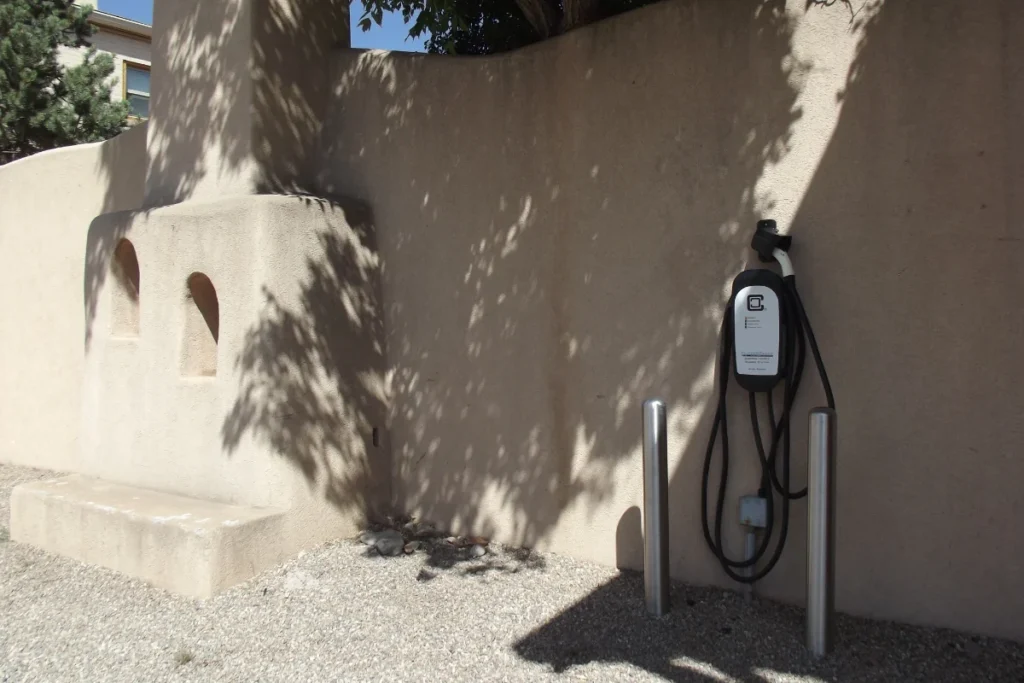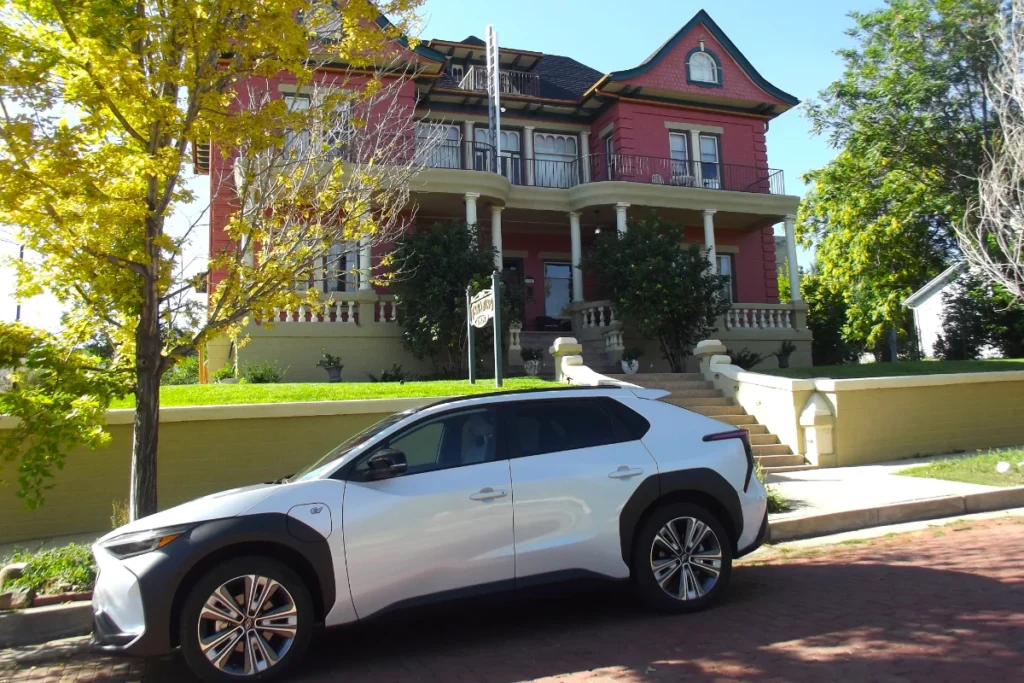EV senic byways bring adventure and fun
An electric car? I had never driven one, nor had I even considered doing so. But I was intrigued when I learned of the Colorado Electric Vehicle Byways program. Off I went to have my first EV experience.
Driving a rented Subaru Solterra — I called it my “spaceship” due to its uber-modern design — felt quite similar to a gas-powered car, except that it was silent. No sound is emitted when the car turns on, nor when it turns off. Another big difference, I found, is the need for careful planning. Those who already own EVs know this; but if you have only used your EV locally, there is much to learn and to do.
In 2023, the Colorado Scenic & Historic Byways Commission prioritized the electrification of all 26 byways as an initial milestone for the state to reach its greenhouse gas emission reduction targets. There are now 17 recognized Colorado Electric Scenic Byways. To be designated as an electric byway, dual-port DC fast charging stations must be located at least every 100 miles within the start and finish of the byway. When byways are less than 100 miles, a dual-port DC fast charging station must be available within 15 miles of the start or end of the byway. The Colorado Tourism Office has partnered with the Colorado Department of Transportation and the Colorado Energy Office to assist in installing charging infrastructure in communities along the 26 Colorado Scenic & Historic Byways.
For my EV scenic byway adventure, I chose two in southern Colorado: the Highway of Legends and Santa Fe Trail. They intersect in the town of Trinidad, making a loop. Both boast stunning and unique scenery and are dotted with small- to medium-size towns offering plenty of art, culture, and charm. I traveled in late summer, hoping that I might see some of the first male tarantulas on their annual early autumn mating trek near La Junta.
I was advised by my EV-owning friends to fully charge the car before departing, as one never knows if charging stations along the way will be operational. Since I don’t have a charging station at home, I headed to a nearby gas station, which my PlugShare app informed me had chargers. At the one open port, I lifted the pump handle and was surprised by its heaviness. I couldn’t figure out how to connect it, but fortunately an Uber driver who charges his car there daily offered to help. It was simple once he demonstrated. Thanks to my EV-owner friends’ advice, I had brought a book along to pass the charging time, which was about an hour. Charging times vary greatly according to whether the stations are fast or slow chargers. Charging times on the trip ranged from one hour to six hours.
Highway of Legends EV Scenic Byway: Walsenburg to Trinidad
From Denver, I drove south on I-25 to exit 52 U.S. Route 160 west, toward Walsenburg, where I picked up the Highway of Legends Electric Scenic Byway — Colorado state Route 12. The car was still adequately charged, I was relieved to note, so there was no need to find a charging station yet. Without stops, driving the byway takes two hours, traveling through the San Isabel National Forest, crossing the nearly 10,000-foot Cucharas Pass and the 11,000-foot Cordova Pass.
Walsenburg, with about 3,000 residents and sitting at just over 6,000 feet altitude, is the launch point for the Spanish Peaks region. Folks in this old mining town are very friendly to those from other parts. As I walked through the small, mural-adorned downtown streets, two older men chatting on a park bench tipped their Western hats to me with a cheery “hello.”
I spent an hour perusing the remarkable Museum of Friends and its eclectic variety of some 1,600 works of art, in both permanent and rotating exhibits. The Spanish Peaks Country Welcome Center offers assistance and literature to travelers.
Stopping in the artsy, funky town of La Veta on the eastern side of La Veta Pass, I was enchanted by the combination of ranch country-boho vibe. A certified Colorado Creative District with only about 800 people, La Veta is known as the art hub of Spanish Peaks country, with many galleries and the world-renowned Shalawalla Gallery — a batik school with exquisite, intricate batiks for sale and on display.
I happily discovered that the delightful La Veta Inn has an EV fast charger conveniently located on premises and charges just $10 for guests.
Here, the Francisco Fort Museum — the only original adobe fort still standing in the state — offers Spanish, Native American, and pioneer artifacts from the region, along with a one-room schoolhouse and a saloon from Old La Veta with its bullet-riddled bar.
My next stop was Trinidad, which has an unusual and quite varied history. Today its popularity is due to its expansive red brick streets, dating from the long-gone town brickyard, and to its well-preserved historic buildings including the impressive Temple Aaron, circa 1883 — the oldest continuously operating Jewish synagogue in the mountain West.
From the exceptionally friendly welcome center, I took the free open trolley ride for an hourlong tour of Trinidad and a bit of the surrounding area. It included a stop at Mount San Rafael Hospital to admire an enormous, three-dimensional ceramic mural created by Sister Augusta Zimmer over a four-year period in the 1970s, that depicts the history of Trinidad.
Santa Fe Trail Scenic & Historic Byway: Trinidad to Lamar
After the trolley tour, which is offered from May to Labor Day, I embarked on the Santa Fe Trail Scenic & Historic Byway, en route to La Junta. The route was the famed 19th-century transportation route that connected Missouri to Santa Fe. The 188-mile scenic byway takes four hours without stops to drive from Trinidad to Lamar on U.S. Highways 350 and 50.
I passed through the enormous, 400,000+ acre Comanche National Grassland, and took a side trip to Bent’s Fort, a well-restored and operational former trading post. This route is mostly bucolic prairie and flat farmlands, with very little traffic. The Picket Wire Canyonlands, south of La Junta, feature the largest dinosaur track site in the United States, with more than 1,400 prints in 100 separate trackways. Vogel Canyon is the best spot to view the tarantulas in the autumn. And yes, happily, I did spot two of them, even though it was just early September.
La Junta is home to a quirky and delightful KOA Journey Campground where I spent two nights in a tiny house. The campground is famed for its authentic, very charming, 1928 AT&SF railroad caboose, for which reservations are recommended. The campground is next to a Village Inn with four EV charging stations, and I spent a couple of hours enjoying a hot fudge sundae and several coffees while the car fully charged.
To conclude my EV byway adventure, I had a sophisticated meal at the excellent Tavern 1301 in Lamar’s Cow Palace Inn to fortify myself for the drive home through rural eastern Colorado. Whether in an EV or a gas-operated car, southern Colorado and its scenic byways offer so much history, beauty, art, wildlife, and peace.
Irene Middleman Thomas is a Denver-based writer who thrives on telling underdiscovered and untold stories from all over the world. She is especially proud to promote the lesser-known adventures, people, and destinations in her own state of Colorado.
Learn More About Scenic Byways and EV Charging Stations
More information on scenic byways can be found through the Colorado Department of Transportation, including maps and weather guides.
Plan your routes with COtrip.org to get the latest road conditions, and mark your routes using MyScenicDrive.com.
PlugShare is the world’s largest EV driver community. Users contribute station reviews and photos to help drivers make the most informed charging decisions possible.
There are publicly available chargers in Trinidad, La Veta, La Junta, Lamar, and Walsenburg, as well as in towns and cities on the way.

Preparation Is Key
To avoid range anxiety, EV owners and renters must plan and be flexible. Also, if there are no Level 3 fast chargers, it may take several hours for the car to charge sufficiently to make it to the next stop. If Wi-Fi is needed to download apps, be sure to download them before you leave home. Remote areas don’t always have open Wi-Fi access or reliable cell service.
Charging Resources
In addition to the built-in resources available in many EV models that provide information about charging locations along a route, mapping resources such as PlugShare, ChargePoint, and A Better Route Planner can help EV drivers locate nearby chargers.
These tools show the location of public EV chargers and whether the chargers are currently operational, although it was not always accurate in real time. Try to keep a close eye on your mileage and range. Additionally, the charger you are seeking might be occupied. When renting an EV, ask the car rental company about resources to find operational EV chargers.










